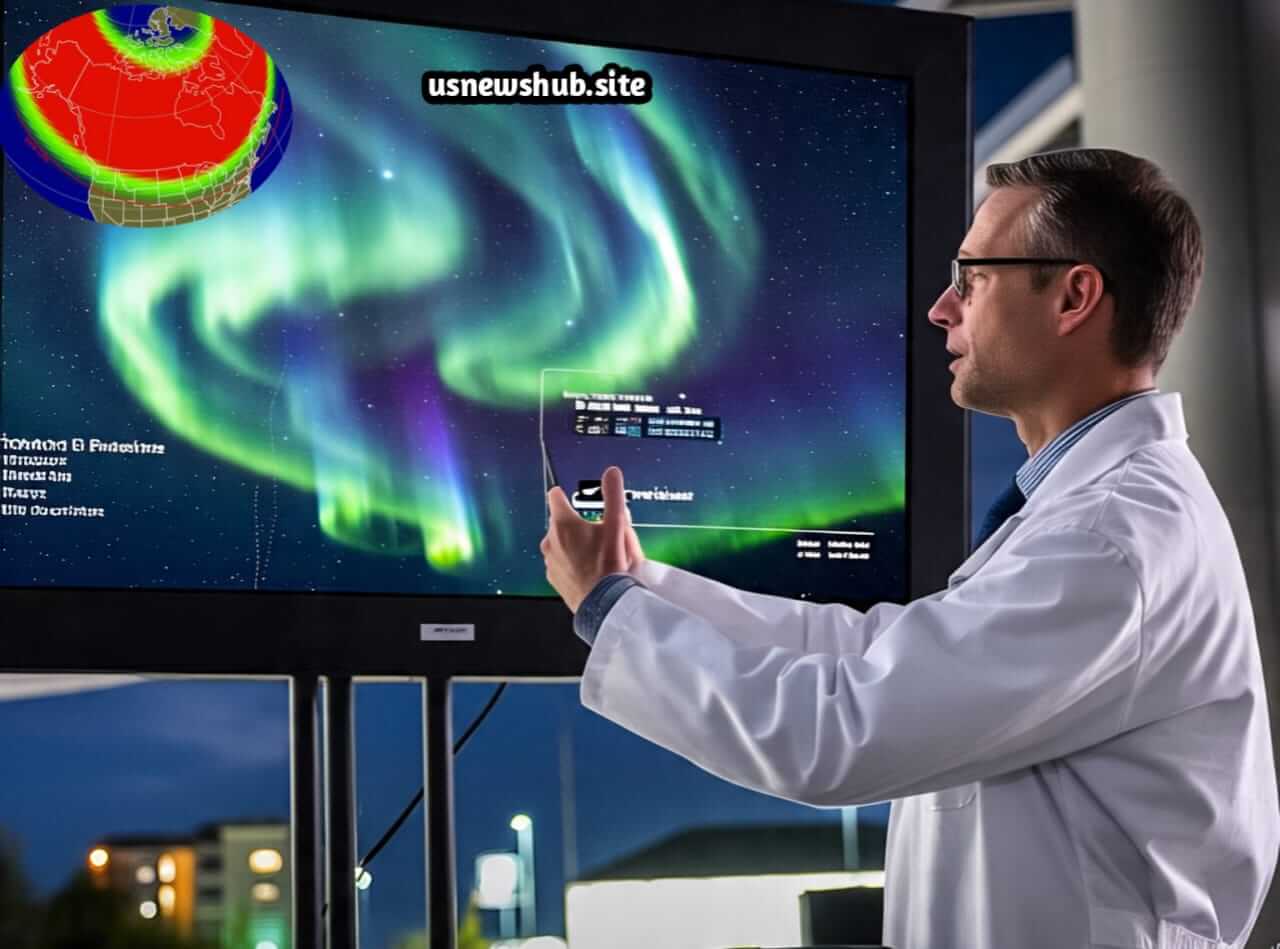Imagine stepping outside your back door and seeing the sky explode in rippling greens and purples. That’s exactly what happened to stunned residents across Minnesota, Wisconsin, and even parts of Iowa and Illinois back in May 2024. The usually elusive Aurora Borealis, or Northern Lights, put on a show so bright it dazzled people hundreds of miles south of its typical haunts. This incredible event wasn’t just luck; it was predicted by scientists tracking the aurora forecast. Want to know if you could see this cosmic ballet soon? Let’s break down how aurora forecasts work and how you can use them!
Holy Protons! What Makes the Northern Lights Happen?
Think of the Sun, not just as a bright light, but as a giant, bubbling ball of super-hot gas. Sometimes, it sends out huge bursts of energy and particles – like a sneeze, but in space! We call these bursts solar storms or geomagnetic storms. When these charged particles (mostly electrons and protons) zoom toward Earth, they get pulled towards the North and South Poles by our planet’s invisible magnetic force field.
As these energetic particles slam into gases in our atmosphere (like oxygen and nitrogen), it’s like tiny collisions that create light! Oxygen glows green (the most common color) and sometimes red. Nitrogen gives us blues and purples. This beautiful light show is the aurora borealis (Northern Lights) near the North Pole, or aurora australis (Southern Lights) near the South Pole.
Geomagnetic Storm: The Engine Behind the Light Show
A geomagnetic storm is like Earth’s magnetic field getting a workout! When a strong solar storm hits us, it shakes up our magnetic shield. The bigger the shake-up, the farther south the aurora becomes visible. That’s why during major geomagnetic storms, people in places like New York or Illinois might see the lights!
Cracking the Code: How Scientists Predict the Aurora Forecast
Predicting the aurora forecast isn’t like guessing if it will rain tomorrow. Scientists use super-smart tools:
- Sun Watchers: Satellites constantly stare at the Sun, looking for sunspots (dark, cooler areas where solar flares erupt) and CMEs (Coronal Mass Ejections – massive clouds of solar particles blasted into space). Spotting a big CME heading our way is the first clue!
- Solar Wind Speedometers: Special spacecraft positioned between the Sun and Earth measure the speed, density, and magnetic direction of the solar wind – the constant stream of particles flowing from the Sun. Sudden jumps signal incoming trouble (or fun, for aurora hunters!).
- Earth’s Magnetic Field Monitors: Ground-based sensors around the globe (like those run by NOAA) track how much our planet’s magnetic field gets shaken up when a geomagnetic storm hits. This shaking is key to how far south the aurora will be visible.
The Magic Number: Understanding the KP Index for Your Aurora Forecast
You’ll often hear forecasters talk about the KP Index. Think of this as the “aurora strength meter.” It runs from 0 (super quiet) to 9 (extreme storm).
- KP 0-2: Aurora mostly confined to the very far north (like Alaska, northern Canada, Scandinavia). Usually not visible in the lower 48 US states.
- KP 3-4: Good chance of visible aurora along the US/Canada border states (like North Dakota, Minnesota, Michigan, Maine) on clear, dark nights.
- KP 5 (G1 Storm): Aurora might dip further south, perhaps to Washington, Oregon, Idaho, Montana, Wisconsin, New York.
- KP 6-7 (G2-G3 Storm): Now we’re talking! Potential for sightings in states like Illinois, Iowa, Nebraska, even Pennsylvania and Massachusetts.
- KP 8-9 (G4-G5 Storm): Rare and major events! Like the May 2024 storm, the aurora can potentially be seen as far south as Alabama or California!
Your Action Plan: How to See the Aurora Tonight (or Soon!)
Okay, you’re excited! How do you turn that aurora forecast into actual sightings?
- Check the Aurora Forecast Daily: Don’t wait for news reports. Make it a habit! Especially look at the 3-day aurora forecast for a heads-up.
- Find Your Darkness: Light pollution is the aurora’s worst enemy. Get out of the city! Parks, rural areas – anywhere dark with clear northern views.
- Look North! The aurora appears near the northern horizon for most people in the US.
- Patience is Key: The aurora often shows up in waves. Give yourself at least an hour.
- Embrace the Night: Your eyes need 20-30 minutes to adjust to the dark. Avoid bright phone screens!
- Watch the Sky, Not Just Apps: Forecasts are predictions, not guarantees. Sometimes the aurora surprises us!
Your Go-To Tools: Finding the Best Aurora Forecast
Where should you look for reliable predictions? Here are the experts:
Northern Lights Forecast: Trusted Sources
- NOAA’s Space Weather Prediction Center (SWPC): The official US government source (swpc.noaa.gov). Offers detailed 3-day aurora forecasts and real-time KP index. Dr. Shawn Dahl, a space weather forecaster, says: “We give solid heads-up for big events, like the one that lit up US skies in May.”
- University of Alaska Fairbanks Geophysical Institute: Excellent aurora forecast maps for North America.
- Reputable Aurora Apps: Apps like “My Aurora Forecast & Alerts” translate complex data into simple predictions for your exact location.
Aurora Forecast United States Tomorrow
Need a quick answer? Check NOAA’s 3-day aurora forecast table (second row is tomorrow!) or use apps with location-based alerts. Remember: Aurora forecast united states tomorrow depends heavily on incoming solar storms – always verify closer to the date!
The 3-Day Aurora Forecast: Your Glimpse into Space Weather
Here’s an example of what a 3-day aurora forecast might look like (always check real-time sources!):
| Forecast Period | Predicted KP | Storm Level | Visibility in USA | Best Viewing Times |
|---|---|---|---|---|
| Tonight | KP 5 | G1 (Minor) | ND, MN, MI, ME, WA, MT | 10 PM – 2 AM |
| Tomorrow | KP 4 | Unsettled | Low chance, far north | 10 PM – 2 AM |
| Day After | KP 6 | G2 (Moderate) | Good in north, possible OR, ID, WI, NY | 10 PM – 3 AM |
Where to Chase the Magic: Best US Spots for Aurora Borealis
While big geomagnetic storms can bring the lights far south, these spots offer your best chance:
- Alaska: The #1 spot! Fairbanks and Denali National Park see frequent displays.
- Northern Minnesota: Voyageurs National Park has incredibly dark skies.
- Upper Peninsula of Michigan: Remote areas near Lake Superior (Marquette, Keweenaw).
- North Dakota & Montana: Wide-open spaces near the Canadian border.
- Maine: Aroostook County offers prime darkness.
Pro Tip:
Even in these spots, you still need a strong aurora forecast (KP 4+) and clear skies!
FAQs
Q: When can I see aurora in the USA?
A: Best during dark months (Sept-April) when a geomagnetic storm hits (KP 5+). Check the aurora forecast united states tomorrow often!
Q: How to see the aurora tonight?
A: 1. Check a reliable aurora forecast 2. If KP 5+, find DARKNESS 3. Look NORTH 4. Be patient!
Q: What is the most accurate aurora borealis forecast?
A: NOAA’s Space Weather Prediction Center is the gold standard. Apps use their data.
Q: How do I check aurora in my location?
A: Use aurora forecast apps (like My Aurora Forecast). They show predictions specifically for you.
Q: Where is the best place in the U.S. to see the northern lights?
A: Alaska is #1! For lower 48: Minnesota, Michigan’s UP, North Dakota, Montana, Maine.
Q: Which country can see aurora?
A: Aurora borealis: Norway, Sweden, Finland, Iceland, Canada, Alaska. Aurora australis: Antarctica, New Zealand, Australia (Tasmania).
Q: Is aurora seen everyday?
A: No! It needs solar activity + clear dark skies. Quiet periods can last weeks.
Don’t Miss the Next Cosmic Show!
The aurora borealis is one of nature’s most breathtaking wonders. By understanding the aurora forecast, knowing your KP index, escaping light pollution, and packing patience, you boost your chances of seeing the sky dance. Sign up for alerts from NOAA or aurora apps, and get ready to look up – the next magical geomagnetic storm could be heading our way! ✨



